| |
(Please note: The following is for information purpses only. Chivalry-Now does not accept responsibility for anyone who is harmed in
the performance of these exercises.)
Once you begin study under a qualified teacher, an
excellent way to learn the use of the long-sword is to
practice the individual guards or postures, shown below, by transitioning
from one to the other. Try to visualize how you would step, strike,
parry and thrust from each position. Analyze the guards to figure
out what advantages and disadvantages each one offers. In a real
fight, keep moving from one position to another
unpredictably with appropriate footwork so that your opponent
has to adjust and cannot exploit any weaknesses.
|
| |

|
The Renewed
Commitment: "Arete' " (pronounced ah-ree-tay in English)
The battle cry
of Chivalry-Now is Arete', a Greek term which means "the
greatest good" or "highest virtue." For human beings,
the highest virtue is a fusion of reason and compassion.
During the commitment, we remind ourselves of the meaning of Arete' and re-dedicate ourselves to it. The word is also used as a greeting
of recognition between the members of Chivalry-Now.
|
| |

|
Normal grip of two-hand sword
The right hand
aims the blade, the left provides power.
In this position, the top edge of the blade is
called the false or short edge.
The lower edge is called the true or long edge. |
| |

|
"Thumb
grip" used for special techniques in the Liechtenauer style.
In this position, the top edge of the blade is
called the false or short edge.
The lower edge is called the true or long edge.
(Please notice that the relationship of the edge
to the right hand is different because the grip is to the side compared
to the normal grip.)
By
gripping the hilt sideways and supporting it with the thumb on the ricasso, a number of blocks and strikes are possible that
otherwise would not be. The thumb grip allows the sword to be fanned
sideways left and right by turning the right hand. It assures that
the blade of your opponent can be collected in your cross guard
in such positions as the Pflug and Ox. The Shrankhut position depends upon this grip for its surprising angles of defense
and attack.
|
| |
The followiing are from the Italian de Liberi tradition
|
| |
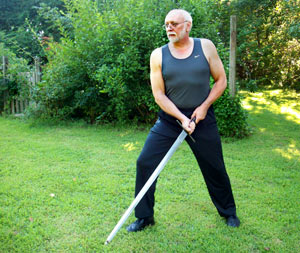
|
Boar's Tooth
Guard (Denti di Chinghalli)
A very stable
guard (stabile, in Italian)) with the right foot forward,
hilt position at the left hip, sword pointing down and forward,
false edge up. Weight can be distributed on the front leg more than
usual so that the back leg is in a position to quickly spring forward.
This position can cut upward with the false edge at the opponent's
hands, or administer a quick thrust to the abdomen. Lifting the
hilt, it can easily assume a Two Horn Guard (Posta Bicornio) for added power. For defense, it pays to practice guard transitions
from this position. For example, moving to a quick hanging guard,
like the Window Guard (Posta Finestra). Although the
weight of the body is slightly forward, leaning in an aggressive
posture, the front leg should be set and ready to push back or to
the side for evasive maneuvers.
|
| |

|
Middle Iron
Gate (Mezzana Porta di Ferro)
A low, center
guard, similar to the German Alber. While this position leaves
the upper body open, the sword is ready for quick responses. Like
all center guards, it can be held with left or right foot forward. |
| |

|
Complete
(or True) Iron Gate (Tutta Porta di Ferro)
Porta di
Ferro or Tutta Porta di Ferro - is one of the main guards
of Fiore's style. Left foot forward, the sword is held down and
to the right, true edge facing the opponent. This stable stance
is valuable because of the potential energy generated from the hips
and arms for quick strikes, low, medium and high. It can be pulled
back into the Extended Long Tail (Code Lunga) for even more
power. A quick step and body turn can produce a left-sided Bicornio,
ready to thrust. It does not offer the blade for the opponent to
control and is easily transitioned into other guards. A step forward
or back with a twist of the hips results in Boar's Tooth (Denti
di Chinghale).
|
| |

|
Extended
Long Tail Guard (Coda Lunga)
A guard position
with the sword in back. With the left foot forward, the sword is
pulled back and down behind the right leg, like a tail dragging
behind. It is hidden from the opponent's view. Powerful strokes
can be generated from this position. It is not good for close distance,
since it takes time to make defensive responses. Hiding the sword
in such a fashion conceals its length and throws off the opponent's
sense of distance. It opens the body up to attack, while issuing
an unseen threat at the same time. Coda Lunga is considered
a transitional position (instabile), during which the sword is swung
back to gain power and direction, and then quickly swings forward.
|
| |

|
Long Guard (Posta Longo)
This position,
similar to Leichtenauer's Longhort, extends the sword forward
toward the opponent's face to protect one's distance. Do not lock
the arms straight. It is a risky guard in that it offers the sword
as an easy target for your opponent to cross blades and steal control.
This can be used deceptively, however, inviting a reaction that
you can be ready for and work from. The point of the sword can also
be used to probe your opponent's guard, testing for reactions to
measure skill, and opening your opponent's guard. It is considered
unstable (instabile) and therefore transitional.
This
is also the position that a sword enters while delivering a long
fendente, or downward stroke. |
| |

|
Woman's Guard (Posta di Donna)
A position that
pulls back the sword dramatically over the should and behind in
order to generate as much power as possible. Can be administered
from back or front stance. Pull the sword over the right shoulder,
winding the arms like a baseball player, yet even more so. The point
can actually be aiming at the opponent. While this looks exaggerated
and slow with the blade way off centerline, it is also provocatively
threatening. A blow from this position is difficult to block.
|
| |

|
Left Woman's
Guard (Posta di Donna Sinestra)
The left side
version of Posta di Donna. Right foot forward, pull the sword
over the left shoulder.
|
| |

|
Proud Woman's
Guard (Posta di Donna Soprana)
An interesting
variation of Posta di Donna in which the body is turned even
more in a back stance, the heels facing the opponent. The sword
runs down the back as if to cover from behind. The arms should be
up and open, so that you can see a larger area. This position is
valuable when fighting multiple opponents who surround you. It is
a strong, threatening position that provides good visibility, and
easily transitions to a guard facing the opposite direction, just
by turning the head. It pays to remember that holding the head slightly
down increases the range of peripheral vision when dealing with
multiple attackers.
|
| |

|
Crown Guard (Posta di Corona, also known as Posta di Frontale)
A center position
where the sword is held high with the cross-guard just below eye-level,
ready to spring upward to catch an incoming downward strike on the
blade, sliding down to the cross-guard. Once the opponent's sword
is collected, it can be dragged down to the side, expended, or otherwise
redirected to make an opening for a strike or thrust. While the
blade is initially held perfectly straight, the hilt (not the point)
is brought a little to the side while collecting the opponent's
sword, turning the cross guard to catch the downward blade. Can
also be used to bind and bridge the gap for grappling.
The picture shows the position meant to gather
the opponent's downward stroke coming in from the left. To gather
one coming in from the right, turn the blade to utilize the true
edge. Make sure that the cross guard is ready to stop his blade. |
| |

|
Middle Guard (Posta Breve)
A middle guard
position where the hilt is held low and to the center. The sword
points upward toward the opponent's face. |
| |

|
Two Horn
Guard center (Posta Bicorno)
A position that
prepares for a powerful thrust. Originally, one lifted the sword's
hilt on the centerline from a Middle Guard (Posta Breve) position
to about the middle of one's chest. The left hand naturally slides
to the base of the pummel, so that the pummel is braced in the palm
of the hand. From here, a strong push is possible. |
| |
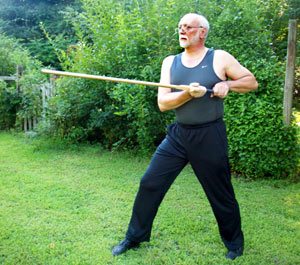
|
Two Horn
Guard left (Posta Bicorno)
Later alternatives
of the Two Horn Guard pull the sword back toward either armpit
to generate thrusting power. From this position, the sword is thrust
forward, preferably with a step. |
| |
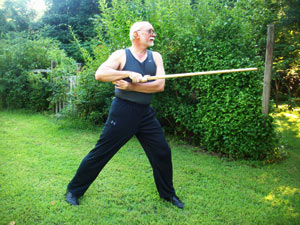
|
Two Horn
Guard right (Posta Bicorno)
The right hand
version of the Two Horn Guard. |
| |
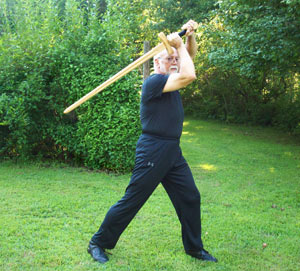
|
Hanging Guard right
The Hanging
Guards are actually transitions, also known as Sloping
Parries. One meets an incoming downward stroke with the
blade offering just enough resistance so as to divert its course.
The objective is for your opponent’s blade to slide down and
away from its intended target. Keep in mind that an actual block,
edge against edge, would damage your sword and might not stop a
full-powered blow. The weak point is the wrist.
You
perform this maneuver by sidestepping and lifting the sword, point
down, in a sloping manner to provide cover. The step provides your
first protection. The sloping angle guides the opponent’s sword
safely downward, leaving you in position for a powerful strike of
your own or to initiate another sloping guard on the other side.
|
| |

|
Hanging Guard left
(See summary
above.) |
| |
The
following are from the German
Liechtenauer tradition
|
| |

|
Guard of
the Roof (Vom Tag on the Shoulder)
Vom Tag over
the Shoulder holds the hilt of the sword near the rib cage on
the right side, with the blade resting on the right shoulder.
A left Vom Tag over the Left Shoulder (see picture below)
can be used, but is not as strong or versatile.
It
sometimes uses the thumb grip, depending upon what you are planning. |
| |

|
Guard
of the Roof left (Vom Tag over the Shoulder) |
| |
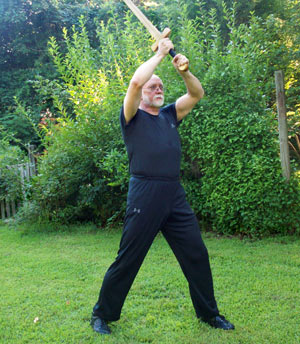
|
Guard of
the Roof Oberhut (Vom Tag over the Head)
Vom Tag over
the Head. The arms are lifted over the head, elbows apart for
visibility, and pommel just above the upper sightline. The sword
can be held vertically or at a 45 degree angle back. This allows
for reaction speed and power, and also adds more tolerance of the
sword's weight, which is a factor in prolonged battle. |
| |

|
Alber (Fool's Guard)
A low, center
guard, similar to the Italian Mezza Porta di Ferro. While
this position leaves the upper body open (hence the reference to fool), the sword is ready for quick responses. Like all center
guards, it can be held with left or right foot forward. |
| |

|
Ox right
(Ochs)
A high, somewhat
extended hanging position, sword reversed with thumb grip underneath
for control. Used for thrusts, blocking and as the end point of
a strike. The Zwerchhau strike can be used from this position.
|
| |

|
Detail
from Ox, showing grip. Notice placement of thumb.
Note also that the cross guard is horizonal,
pointing side to side. |
| |
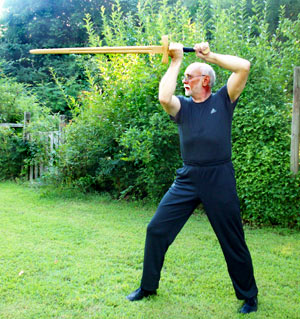
|
Ox left
(Ochs)
Left version
of the above, with thumb grip underneath for control. Used for thrusts,
blocking and the end point of a strike. The Zwerchhau strike can
be used from this position. |
| |
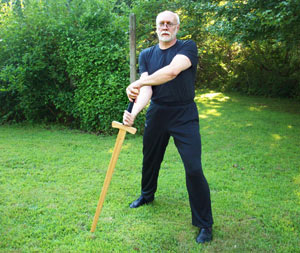
|
Blockade
Guard right (Schrankhut)
A very deceptive,
seemingly awkward guard. The thumb grip is essential to making it
work. Start with left foot forward. Using the thumb grip, swing
the sword down and to the right, until the tip touches the ground,
true edge to the right. The right hand and forearm are quite twisted,
and located on the handle underneath the left, which rests on top.
It appears that you are resting your sword, which offers a blockade
to the lower right side of the body. There does not appear to be
any wind-up energy, but the twisting of the hand and forearm can
instantly provide a quick whipping action up and to the left, like
a windshield wiper. This can parry an incoming strike or, with a
forward sidestep, attack the opponent's hand or head.
|
| |

|
Detail
from Shrankhut, showing grip. Notice placement of thumb. |
| |

|
Blockade
Guard left (Schrankhut)
Left variation
of the above. Because of the arm crossing, this position is not
as fast or powerful as the right one, and needs to be practiced
more in order to master it. |
| |
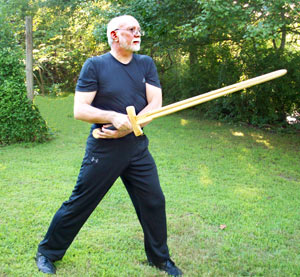
|
Plow (Pflug) right
A middle guard,
with the blade off centerline, held close to the back (right) hip,
aiming at opponent's face. It is well-positioned for a thrust and
provides good interception for an unterhau. Can easily transition
into an Ox (Ochs).
Generally uses thumb grip. |
| |

|
Plow (Pflug) left
A middle guard,
with the blade off centerline, held close to the back (left) hip,
aiming at opponent's face. It is well-positioned for a thrust and
provides good interception for an unterhau. Can easily transition
into an Ochs.
Generally uses thumb grip. |
| |

|
Detail
from Pflug, showing grip. Note placement of thumb. |
| |

|
Wechel (Guard
of the Changer)
A low guard
that might be considered a reverse of Complete Iron Gate (Tutta
Porte di Ferro), with right foot forward and sword to the left,
pointing down. It is the ending point of a Zornhau strike.
It can be used as a Boar's Tooth Guard, capable of striking
upward with the false edge to the opponent's hands or abdomen.
|
| |

|
Lunge
A quick step
forward, usually with the front foot, while executing an extended
thrust. The resulting front leg is bent and low, with the back leg
stretched out behind. Can be initiated with either leg, and sometimes
as a pass with the rear foot.
Stepping back is also possible to form what is
called a Backward Lunge. |
| |

|
Guard of
the Hanging Point (Hangetort)
This is a transitional
guard used for protection. One passes through it when moving from
a low guard to a high, such as the Middle Iron Gate to Ox.
|
| |
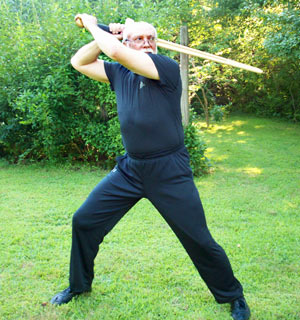
|
Guard of
Wrath (Zornhut)
Similar to dei
Liberi's Woman's Postion (Posta di Donna), this guard presents
a ready position that is well wound for a powerful stroke. This
can be intimidating. The entire body is brought into play, and the
opponent can see that. |
| |

|
Long Guard (Langort)
This position,
simiular to Dei Liberia's Posta Longo, extends the sword
forward toward the opponent's face to protect one's distance. Do
not lock the arms straight. It is a risky guard in that it offers
the sword as an easy target for your opponent to cross blades and
steal control. This can be used deceptively, however, inviting a
reaction that you can be ready for and work from. The point of the
sword can also be used to probe your opponent's guard, testing for
reactions to measure skill, and opening your opponent's guard. It
is considered transitional, not a position to hold while waiting
for attack. |
| |
|
|
|
 |
 |
